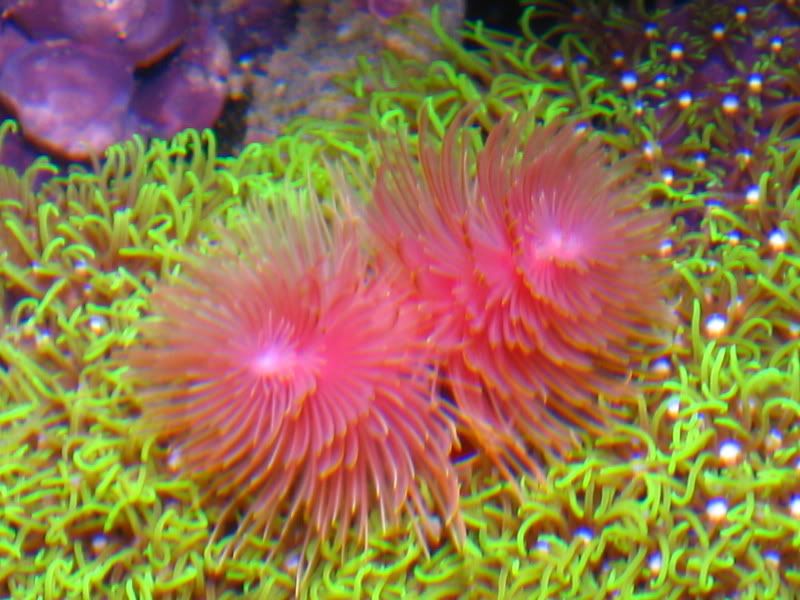Red Coco Worm
- Thread starter kevin34
- Start date
N
nemo_66
Guest
i dont know much about them, but i know that they are definately reef safe, thats like saying will a clownfish eat and bubble tip, there made for each other, you know... but thats all i know
michaeltx
Moderator
why are they so expensive
because of their bright red coloration and becase there are very few BRIGHT red colors available for our hobby when they do show up they fetch a pretty penny. They are very simlair to feathdusters though. I will dig up some more info on them tomorrow for you.
mike
because of their bright red coloration and becase there are very few BRIGHT red colors available for our hobby when they do show up they fetch a pretty penny. They are very simlair to feathdusters though. I will dig up some more info on them tomorrow for you.
mike
fishwanabe
Member
Kevin-demartini has one in her tank, I try to let her know about this thread maybe she can give you some info
michaeltx
Moderator
Care Level: Difficult
Tank Conditions: 72-78°F; sg 1.023-1.025; pH 8.1-8.4; dKH 8-12
Max. Size In Aquarium: Up to 7"
Color Form: Orange, Pink, Red, White, Yellow
Temperament: Peaceful
Reef Compatible: Yes
Diet: Omnivore
Origin: Indo-Pacific
Family: Serpulidae
The Hard Tube Coco Worm, also known as the Hard Tube Feather Duster, Protula Tubeworm, or Hard Tubeworm, has a crown that can be white, yellow, orange, pink, or red. The radioles may be banded or patterned. Younger Hard Tube Coco Worms have bi-lobed crowns, while the crowns of older individuals are spiraled.
The Hard Tube Coco Worm secretes a calcareous tube, approximately 1/2 inch in diameter and 5-8 inches long, to house its vulnerable worm body. When disturbed, it can quickly retract its crown and close its operculum to shut the top of its tube. It usually anchors its tube in a crevice of the rocky reef or in the gravel along current-swept reef slopes. It uses the radioles to filter out floating plankton.
The aquarium for the Hard Tube Coco Worm should be well-established and contain a rock and gravel substrate. The Hard Tube Coco Worm requires calcium and the proper alkalinity to grow. It is extremely intolerant of poor water quality and copper-based medications.
In the aquarium it is difficult to maintain, and will need supplements of phytoplankton and liquid organic foods.
HTH some
Mike
Tank Conditions: 72-78°F; sg 1.023-1.025; pH 8.1-8.4; dKH 8-12
Max. Size In Aquarium: Up to 7"
Color Form: Orange, Pink, Red, White, Yellow
Temperament: Peaceful
Reef Compatible: Yes
Diet: Omnivore
Origin: Indo-Pacific
Family: Serpulidae
The Hard Tube Coco Worm, also known as the Hard Tube Feather Duster, Protula Tubeworm, or Hard Tubeworm, has a crown that can be white, yellow, orange, pink, or red. The radioles may be banded or patterned. Younger Hard Tube Coco Worms have bi-lobed crowns, while the crowns of older individuals are spiraled.
The Hard Tube Coco Worm secretes a calcareous tube, approximately 1/2 inch in diameter and 5-8 inches long, to house its vulnerable worm body. When disturbed, it can quickly retract its crown and close its operculum to shut the top of its tube. It usually anchors its tube in a crevice of the rocky reef or in the gravel along current-swept reef slopes. It uses the radioles to filter out floating plankton.
The aquarium for the Hard Tube Coco Worm should be well-established and contain a rock and gravel substrate. The Hard Tube Coco Worm requires calcium and the proper alkalinity to grow. It is extremely intolerant of poor water quality and copper-based medications.
In the aquarium it is difficult to maintain, and will need supplements of phytoplankton and liquid organic foods.
HTH some
Mike








